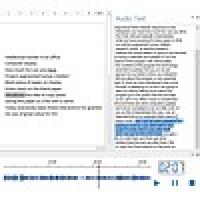Designing Prosthetic Memory: Audio or Transcript, That is the Question

Audio recordings and the corresponding transcripts are often used as prosthetic memory (PM) after meetings and lectures. While current research is mainly developing novel features for prosthetic memory, less is known on how and why audio recordings and transcripts are used. We investigate how users interact with audio and transcripts as prosthetic memory, whether interaction strategies change over time, and analyse potential differences in accuracy and efficiency. In contrast to the subjective user perception, our results show that audio recordings and transcripts are equally efficient, but that transcripts are generally preferred due to their easily accessible contextual information. We further identified that prosthetic memory is not only used as a recall aid but frequently also consulted for verifying information that has been recalled from organic memory (OM). Our findings are summarised in a number of design implications for prosthetic memory solutions.
Publication Reference
Trullemans, S., Ebrahimi, P., and Signer, B.: "Designing Prosthetic Memory: Audio or Transcript, That is the Question", Proceedings of AVI 2018, International Working Conference on Advanced Visual Interfaces, Grosseto, Italy, May 2018




